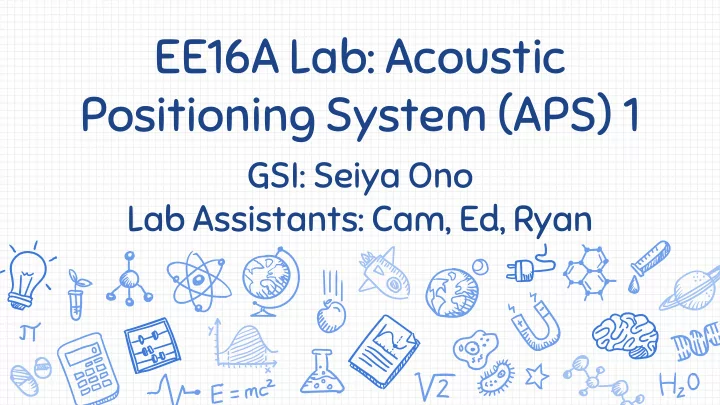

EE16A Lab: Acoustic Positioning System (APS) 1 GSI: Seiya Ono Lab Assistants: Cam, Ed, Ryan
Announcements ✘ Lab Grades on Gradescope Just email me~ no problem ✗
Where Are We Now? Imaging Touchscreen Intro APS Module Module Module Module
Today’s Lab: APS ✘ Global Positioning System (GPS) ✘ Understanding mathematical tools used for sifting and detecting signals (cross-correlation) Topics From Class: ✘ Correlation ✘ Lateration (Week 2) ✘ Least Squares (Week 3)
GPS? There are satellites in the sky (beacons) ✘ Satellites send signals at known times (beacons are ✘ synchronized) Receiver gets these signals ✘ From time-delay of a beacon signal, receiver ✘ calculates distance to the beacon From distances to satellites, position is determined ✘ by lateration
Time of Flight ✘ Receiver gets signals from multiple satellites at the same time (“raw” signals) ✘ Each satellite sends a particular beacon waveform ✘ Receiver determines when this beacon is received, with reference to when other beacons are received
Cross-correlation ✘ Mathematical tool for finding similarities between signals ✘ Cross-correlation : Take g and slide over f , find area of product for different sliding amount ✗ Sliding Dot Product ✘ Cross-correlation is plotted over sliding amount ✘ Peak of cross-correlation → sliding amount that makes g “most similar” to f
Cross-Correlation: How We’ll Use It ✘
Cross-correlation “Sliding Dot Product”
Cross-Correlation: Beacon 1 ✘ Find the index at which the maximum occurs (25)
Cross-Correlation: Beacon 2 ✘ Find the index at which the maximum occurs (12)
Cross-Correlation: An Example 1. Pad signals with zeros 2. Align last index of X2 with first index of X1 3. Multiply signals and sum (dot product) 4. Shift X2 to the right by one 5. Repeat 3 + 4 until the first index of X2 reaches the last index of X1 X1 = [1 2 3] X2 = [3 2 1]
Cross-Correlation: An Example 1. Pad signals with zeros X1 = [0 0 1 2 3] X2 = [3 2 1 0 0]
Cross-Correlation: An Example 2. Align last index of X2 with first index of X1 X1 = [0 0 1 2 3] X2 = [3 2 1 0 0]
Cross-Correlation: An Example 3. Multiply signals and sum (dot product) X1 = [0 0 1 2 3] X2 = [3 2 1 0 0] M = [0 0 1 0 0] CC[1] = 1
Cross-Correlation: An Example 4. Shift X2 to the right by one X1 = [0 0 1 2 3] X2 = [0 3 2 1 0 ]
Cross-Correlation: An Example 5. Repeat 3 + 4 until the first index of X2 reaches the last index of X1 X1 = [0 0 1 2 3] X2 = [0 3 2 1 0 ] M = [0 0 2 2 0] CC[2] = 4
Cross-Correlation: An Example 5. Repeat 3 + 4 until the first index of X2 reaches the last index of X1 X1 = [0 0 1 2 3] X2 = [0 0 3 2 1] M = [0 0 3 4 3] CC[3] = 10
Cross-Correlation: An Example 5. Repeat 3 + 4 until the first index of X2 reaches the last index of X1 X1 = [0 0 1 2 3] X2 = [1 0 0 3 2] M = [0 0 0 6 6] CC[4] = 12
Cross-Correlation: An Example 5. Repeat 3 + 4 until the first index of X2 reaches the last index of X1 X1 = [0 0 1 2 3] X2 = [2 1 0 0 3] M = [0 0 0 0 9] CC[5] = 9
Notes ✘ SAVE THE IPYNB FILE for the next lab!! ✘ Helpful functions: ✗ np.dot, np.array, np.argmax …. ✘ Make sure mic is plugged into the mic port ✘ Audio should look like: [Not a squiggly line] ✘ Return mics at the end! Check off : tinyurl.com/16a-lab-checkoff Question Queue: tinyurl.com/lab108-q Presentation: Check inst website!
Recommend
More recommend